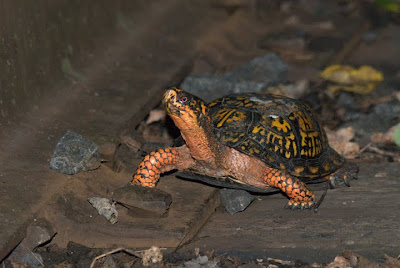Our RSSE adventures have led us to a variety of encounters with different organisms. One of these is the Cicada exoskeletons that many of the Young Naturalists have been finding. These are the Dog Day Cicadas that you hear buzzing in the trees during the day. These insects are about a year old and have spent most of their lives underground. They hatched last August or September from eggs that were laid in the tips of tree branches. After hatching they dropped out of the tree and tunneled into the soil where they lived, surviving on plant juices that they sucked out of roots until coming out from their underground home in the last few weeks. When they crawled out of the ground they climbed up tree trunks, fence posts and other objects where they shed their exoskeleton and emerged with wings. They have flown up into the trees where they buzz to attract mates.
On the early morning bird walk we saw or heard 7 species of birds including House Sparrow, American Crow, Starling, Catbird, Rock Pigeon, American Goldfinch and Northern Cardinal. But the most exciting find was a young Woodchuck. Many people know the Woodchuck as a Ground Hog, but it has many other names including Whistle Pig and Marmot. Some one even mentioned that there is a Pennsylvania Dutch name for them but they couldn’t remember what it was. Since animals like the Woodchuck often do have so many common names, scientist will use the scientific name to be sure that other scientist are clear about what animal they are talking about. The scientific name for the Woodchuck is Marmota monax.
On the early morning bird walk we saw or heard 7 species of birds including House Sparrow, American Crow, Starling, Catbird, Rock Pigeon, American Goldfinch and Northern Cardinal. But the most exciting find was a young Woodchuck. Many people know the Woodchuck as a Ground Hog, but it has many other names including Whistle Pig and Marmot. Some one even mentioned that there is a Pennsylvania Dutch name for them but they couldn’t remember what it was. Since animals like the Woodchuck often do have so many common names, scientist will use the scientific name to be sure that other scientist are clear about what animal they are talking about. The scientific name for the Woodchuck is Marmota monax.

Another cool organism that we’ve encountered is the Bird Nest Fungus. It is growing in several places under the trees along the sidewalk in front of the Williams Center. As you can see from the photos I took the fungus’ fruiting body is smaller than a penny. The majority of the fungus though is the fungal mycelia that grows under the wood chips and eats up the food energy stored in the dead wood. Look carefully inside the fungal cup and you’ll see some little lumps that make the whole body look like a miniature bird nest complete with tiny eggs – hence the name Bird Nest Fungus. When rain water splashes into the cup fungal spore are propelled out to spread about and grow into new fungi.



2 comments:
ray ban sunglasses outlet
louis vuitton
christian louboutin heels
cheap jerseys
ugg outlet
coach outlet online
nba jerseys
bulls jerseys
coach outlet
abercrombie and fitch
chenyingying20161213
fitflop shoes
ugg outlet
coach factory outlet
tod's shoes
air max uk
patriots jerseys
gucci handbags
adidas nmd runner
coach factory outlet
ugg boots
chenyingying20161213
Post a Comment